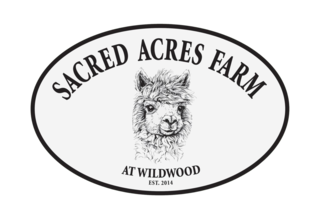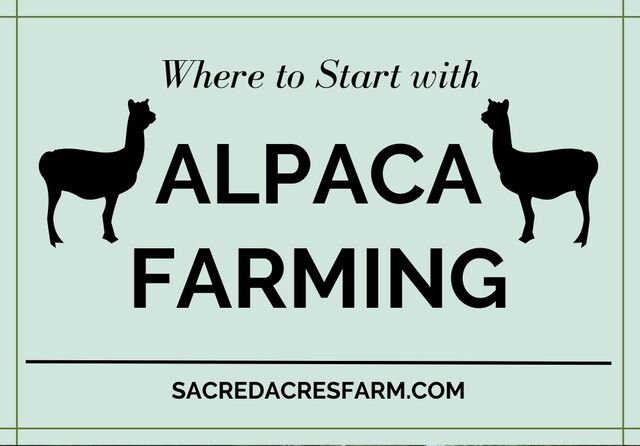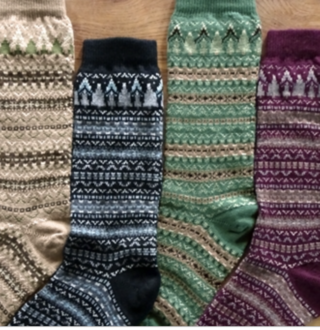4 Priorities to Get Started Alpaca Farming
Wednesday, August 10, 2022
Hey Farm Friends,
It is fascinating how little things can drastically change the outcome of a person’s life.
Sacred Acres Alpaca Farm may be 5 years old, but the mustard seed was planted in 1993 when the owner, Maryjane Cathers, bought a sweater. A simple, soft blue sweater spiraled into an adoration for alpaca. She "fell in love with the silky feel and the weight and texture of alpaca fiber." And true to form with the durability of alpaca fiber, she still wears it to this day through cold winter chills. From there she developed an affinity to alpaca fiber and "began to look for it whenever [she] was starting a new knitting project."
Back in 1982, the owner and her husband bought 28 acres of open land in Fluvanna County with the intention of moving and farming some of the land in the 90s. These plans were cut short as Maryjane became the primary caregiver for her husband in 2010 through his dementia. A year before her husband passed, MaryJane attended a two-day seminar at the Alpaca Boutique in Gordonsville (retired in 2019) of "Everything You Need to Know to Raise Alpacas." It was this class and the proceeding research into farming that really brought the farm into fruition. Alpaca farming was a lifestyle choice and commitment for Maryjane and she truly sees a future for those who consider taking on this venture like her. It is a pursuit of passion for farming, dedication to conservation, and love for these animals.
Everyone has to start somewhere, so let's start with boarding.
In 2014, Sacred Acres Alpaca Farm purchased our first 4 alpacas—2 pregnant females and 2 juvenile males. The alpacas were boarded for the first 3 years while the basic farm infrastructure was being developed—fencing, hay & grain storage, pasture, & shelter. Boarding is a common practice for new alpaca owners wanting to start their herd and get familiar with the animals and farming while preparing their property for moving the animals home. For the better part of 2016 and 2017, it was all development on Sacred Acres. Clearing through four acres of land, manicuring the walking trails, & preparing a welcoming home for the alpaca. There are many reasons to board animals and the space and time to develop was one of the benefits Sacred Acres obtained during this transitional period.
#1) Land for Alpacas
The first focus when getting started with alpacas is land. The consensus across the internet most commonly noted is 7 alpacas for 1 acre of good pasture, but the less there are the more room available within that space. Sacred Acres Alpaca Farm limits its herd size to 7 per acre, which caps out the farm at 25-30 animals. Five acres of the 28 are open pastures, farm building, and the house. By good pasture, this means plenty of space to roam, grass and leaves to graze on (check out some videos of the herd grazing over on Sacred Acres Farm at Wildwood’s YouTube channel). Alpacas do not do well when they are alone, they will be very unhappy, which may cause health problems and a premature death. So it is vital to keep in mind when considering beginning an alpaca farm that in order to start a herd, 2 or 3 is the expected minimum. 3 is more recommended for the unfortunate instance of if one were to pass, the remaining two can still maintain each others company and keep the herd dynamic until a replacement can be purchased without too much of a rush.
One of the big benefits to owning alpacas is the low impact on the environment they have. Unlike many other livestock, Alpaca maintain a communal dung pile. This assists in land management by making cleanup easier. Land management is very important to keep in mind during the creation of a farmstead. It is a conscious effort to maintain the delicate balance of scarce resources in a way that preserves the environment for future generations to come.
The remaining 23 acres are wooded and have trails winding through them where visitors can stroll along the silent serenity of the farm's woods. Trails can be tricky to maintain in the Virginia weather. Virginia summers are long, muggy, and wet. Temperatures can range from the mid-80s towards upper 90s. Thunderstorms and downpours can bring down trees and muddy trails. It truly takes a village to maintain the upkeep of the farm. Thankfully, the amazing team here at Sacred Acres Alpaca Farm that keeps the farm operating smoothly.
One of the best things to remember when taking on big tasks like beginning an alpaca farm is that it never needs to be a journey of solitude. There are so many resources available to assist along the journey, enlighten, and to provide insight. Hopefully this blog becomes that to whomever seeks it. :)
#2) Fencing for Alpacas
True to their gentle nature, Alpacas are not the type to test fencing. It is not mandatory to have electricity or anything too intensive. The fence is to keep other animals out more than to keep the alpacas in. As prey animals, the alpaca are going to remain inside of these safe zones that have been created for them. They will not jump over the fences. On Sacred Acres Alpaca Farm, there are electric fences as a deterrent to local predators. At sun down, when the alpaca are in their sheds for the night, the electric fence is turned on. Then it is turned off at sun rise, as the alpaca are waking up for the day. This is to maintain a safe environment for the animals at night. The electric fences are only along the perimeter of the farm and not near where the animals sleep so as to mitigate any incidents of tinged coats from rubbing up against the fence, as alpacas are ones to do.
With alpacas, there is no specific mating season. So another use of the fences is to keep the males and females separated until they are intentionally being bred. Males will try to mate continuously with the female alpaca, which can cause health problems within the females. When creating or choosing fencing, ensure that the females and males do not have any ability to have physical contact within their fencing. This will help with the males not driving themselves crazy that the girls are right there.
#3) Shelter for Alpacas
Alpacas do great in an array of different environments, which makes sense as they originate from the mountains of South America and can withstand the diverse climates available there. A 3-sided shelter typically can work just fine for alpaca and it is what is utilized on Sacred Acres Alpaca Farm. A note about the 3-sided shelter for Virginia Farmers is that it is best to orient them towards the North. This is because Virginia winds tend to originate from the west. So for different inclement weather like the rain, the alpaca remain in a safe, dry enclosure. The typical rule of thumb that is recommended is about 30 sq. ft. per alpaca. So to put that into a simplistic perspective, think about a full-sized mattress for each alpaca. For Sacred Acres, we have a 10x10 pin for 7 animals. Typically fewer when working with the males taking their nature and personalities into consideration. A priority when creating shelters is an area to corral the alpaca, this is beneficial for different scenarios that they may get spooked like getting medications.
Herd Heath is a frequent routine for the alpaca, needing 1 or 2 shots a month. This becomes even more frequent, of course, under certain circumstances like pregnancy where it increases to more weekly visits and shots. Having the herd together during these medical checks is vital for creating a secure environment for the animals. Nobody enjoys doctors visits, and alpacas even less so. However, having the herd helps create a more comfortable environment to make these visits tolerable and less stressful overall.
#4) Grain and Hay Storage
The main source of nutrients for alpaca is hay, grain, and grass in the pasture. With the facial anatomy of alpacas, they only have a bottom row of teeth and then a hard pallet on the tops of their mouths. So when they are eating grass, they are actually not pulling it out of the ground. Instead, they use a figure-eight motion with their mouth to actually chop the grass. Alpacas can also eat feeds with mineral mixes that are available through local feed stores. Typically, when alpacas eat out of a person’s hand it is the pellet feed that they nibble up. For Sacred Acres Alpaca Farm, there are feeders that are filled with hay that the alpaca have access to whenever they please that they also supplement with grazing along the pasture. The hay used on Sacred Acres is orchard grass hay, which is locally grown. When searching for hay and grain suppliers, it is essential to be diligent about the quality of the supply and its usability. Crabgrass is a contaminant that farmers need to be mindful of avoiding in their hay. When crabgrass is dried, it is completely unusable to the alpaca as it is as hard as plastic and they are unable to consume it. As with any new venture, setting aside time for dedicated research and minding these fundamental details truly pays off in the long term. By getting this basic infrastructure in place, it helps develop and grow the farm from a sustainable place.
These are just the starting points, the foundation to a beautiful farm. There is so much time, dedication, passion, and research that goes into every detail of running an alpaca farm. It truly is a lifestyle shift. Across Sacred Acres social media, there is so much planned for hopefully being able to address and truly delve into all the aspects to educate and inform about this rewarding venture. And if scrolling isn’t enough, feel free to schedule a farm tour, call (703)945-0766. Farm tours are unforgettable educational experiences. Hands on is always one of the best ways to learn, and there is no more hands on than actually being on the farm. It includes a walkthrough of the farm, a meet-and-feed with the herd, and a studio demonstration of how the raw fiber is processed to prepare it for spinning yarn. Please call or email to set up a visit, currently the website is not processing payments to check out. This issue is being addressed, however in the meanwhile it is requested visitors either call (703)945-0766 or email through “Contact Us” page to schedule. Have a beautiful week and take care.
It is fascinating how little things can drastically change the outcome of a person’s life.
Sacred Acres Alpaca Farm may be 5 years old, but the mustard seed was planted in 1993 when the owner, Maryjane Cathers, bought a sweater. A simple, soft blue sweater spiraled into an adoration for alpaca. She "fell in love with the silky feel and the weight and texture of alpaca fiber." And true to form with the durability of alpaca fiber, she still wears it to this day through cold winter chills. From there she developed an affinity to alpaca fiber and "began to look for it whenever [she] was starting a new knitting project."
Back in 1982, the owner and her husband bought 28 acres of open land in Fluvanna County with the intention of moving and farming some of the land in the 90s. These plans were cut short as Maryjane became the primary caregiver for her husband in 2010 through his dementia. A year before her husband passed, MaryJane attended a two-day seminar at the Alpaca Boutique in Gordonsville (retired in 2019) of "Everything You Need to Know to Raise Alpacas." It was this class and the proceeding research into farming that really brought the farm into fruition. Alpaca farming was a lifestyle choice and commitment for Maryjane and she truly sees a future for those who consider taking on this venture like her. It is a pursuit of passion for farming, dedication to conservation, and love for these animals.
Everyone has to start somewhere, so let's start with boarding.
In 2014, Sacred Acres Alpaca Farm purchased our first 4 alpacas—2 pregnant females and 2 juvenile males. The alpacas were boarded for the first 3 years while the basic farm infrastructure was being developed—fencing, hay & grain storage, pasture, & shelter. Boarding is a common practice for new alpaca owners wanting to start their herd and get familiar with the animals and farming while preparing their property for moving the animals home. For the better part of 2016 and 2017, it was all development on Sacred Acres. Clearing through four acres of land, manicuring the walking trails, & preparing a welcoming home for the alpaca. There are many reasons to board animals and the space and time to develop was one of the benefits Sacred Acres obtained during this transitional period.
#1) Land for Alpacas
The first focus when getting started with alpacas is land. The consensus across the internet most commonly noted is 7 alpacas for 1 acre of good pasture, but the less there are the more room available within that space. Sacred Acres Alpaca Farm limits its herd size to 7 per acre, which caps out the farm at 25-30 animals. Five acres of the 28 are open pastures, farm building, and the house. By good pasture, this means plenty of space to roam, grass and leaves to graze on (check out some videos of the herd grazing over on Sacred Acres Farm at Wildwood’s YouTube channel). Alpacas do not do well when they are alone, they will be very unhappy, which may cause health problems and a premature death. So it is vital to keep in mind when considering beginning an alpaca farm that in order to start a herd, 2 or 3 is the expected minimum. 3 is more recommended for the unfortunate instance of if one were to pass, the remaining two can still maintain each others company and keep the herd dynamic until a replacement can be purchased without too much of a rush.
One of the big benefits to owning alpacas is the low impact on the environment they have. Unlike many other livestock, Alpaca maintain a communal dung pile. This assists in land management by making cleanup easier. Land management is very important to keep in mind during the creation of a farmstead. It is a conscious effort to maintain the delicate balance of scarce resources in a way that preserves the environment for future generations to come.
The remaining 23 acres are wooded and have trails winding through them where visitors can stroll along the silent serenity of the farm's woods. Trails can be tricky to maintain in the Virginia weather. Virginia summers are long, muggy, and wet. Temperatures can range from the mid-80s towards upper 90s. Thunderstorms and downpours can bring down trees and muddy trails. It truly takes a village to maintain the upkeep of the farm. Thankfully, the amazing team here at Sacred Acres Alpaca Farm that keeps the farm operating smoothly.
One of the best things to remember when taking on big tasks like beginning an alpaca farm is that it never needs to be a journey of solitude. There are so many resources available to assist along the journey, enlighten, and to provide insight. Hopefully this blog becomes that to whomever seeks it. :)
#2) Fencing for Alpacas
True to their gentle nature, Alpacas are not the type to test fencing. It is not mandatory to have electricity or anything too intensive. The fence is to keep other animals out more than to keep the alpacas in. As prey animals, the alpaca are going to remain inside of these safe zones that have been created for them. They will not jump over the fences. On Sacred Acres Alpaca Farm, there are electric fences as a deterrent to local predators. At sun down, when the alpaca are in their sheds for the night, the electric fence is turned on. Then it is turned off at sun rise, as the alpaca are waking up for the day. This is to maintain a safe environment for the animals at night. The electric fences are only along the perimeter of the farm and not near where the animals sleep so as to mitigate any incidents of tinged coats from rubbing up against the fence, as alpacas are ones to do.
With alpacas, there is no specific mating season. So another use of the fences is to keep the males and females separated until they are intentionally being bred. Males will try to mate continuously with the female alpaca, which can cause health problems within the females. When creating or choosing fencing, ensure that the females and males do not have any ability to have physical contact within their fencing. This will help with the males not driving themselves crazy that the girls are right there.
#3) Shelter for Alpacas
Alpacas do great in an array of different environments, which makes sense as they originate from the mountains of South America and can withstand the diverse climates available there. A 3-sided shelter typically can work just fine for alpaca and it is what is utilized on Sacred Acres Alpaca Farm. A note about the 3-sided shelter for Virginia Farmers is that it is best to orient them towards the North. This is because Virginia winds tend to originate from the west. So for different inclement weather like the rain, the alpaca remain in a safe, dry enclosure. The typical rule of thumb that is recommended is about 30 sq. ft. per alpaca. So to put that into a simplistic perspective, think about a full-sized mattress for each alpaca. For Sacred Acres, we have a 10x10 pin for 7 animals. Typically fewer when working with the males taking their nature and personalities into consideration. A priority when creating shelters is an area to corral the alpaca, this is beneficial for different scenarios that they may get spooked like getting medications.
Herd Heath is a frequent routine for the alpaca, needing 1 or 2 shots a month. This becomes even more frequent, of course, under certain circumstances like pregnancy where it increases to more weekly visits and shots. Having the herd together during these medical checks is vital for creating a secure environment for the animals. Nobody enjoys doctors visits, and alpacas even less so. However, having the herd helps create a more comfortable environment to make these visits tolerable and less stressful overall.
#4) Grain and Hay Storage
The main source of nutrients for alpaca is hay, grain, and grass in the pasture. With the facial anatomy of alpacas, they only have a bottom row of teeth and then a hard pallet on the tops of their mouths. So when they are eating grass, they are actually not pulling it out of the ground. Instead, they use a figure-eight motion with their mouth to actually chop the grass. Alpacas can also eat feeds with mineral mixes that are available through local feed stores. Typically, when alpacas eat out of a person’s hand it is the pellet feed that they nibble up. For Sacred Acres Alpaca Farm, there are feeders that are filled with hay that the alpaca have access to whenever they please that they also supplement with grazing along the pasture. The hay used on Sacred Acres is orchard grass hay, which is locally grown. When searching for hay and grain suppliers, it is essential to be diligent about the quality of the supply and its usability. Crabgrass is a contaminant that farmers need to be mindful of avoiding in their hay. When crabgrass is dried, it is completely unusable to the alpaca as it is as hard as plastic and they are unable to consume it. As with any new venture, setting aside time for dedicated research and minding these fundamental details truly pays off in the long term. By getting this basic infrastructure in place, it helps develop and grow the farm from a sustainable place.
These are just the starting points, the foundation to a beautiful farm. There is so much time, dedication, passion, and research that goes into every detail of running an alpaca farm. It truly is a lifestyle shift. Across Sacred Acres social media, there is so much planned for hopefully being able to address and truly delve into all the aspects to educate and inform about this rewarding venture. And if scrolling isn’t enough, feel free to schedule a farm tour, call (703)945-0766. Farm tours are unforgettable educational experiences. Hands on is always one of the best ways to learn, and there is no more hands on than actually being on the farm. It includes a walkthrough of the farm, a meet-and-feed with the herd, and a studio demonstration of how the raw fiber is processed to prepare it for spinning yarn. Please call or email to set up a visit, currently the website is not processing payments to check out. This issue is being addressed, however in the meanwhile it is requested visitors either call (703)945-0766 or email through “Contact Us” page to schedule. Have a beautiful week and take care.





